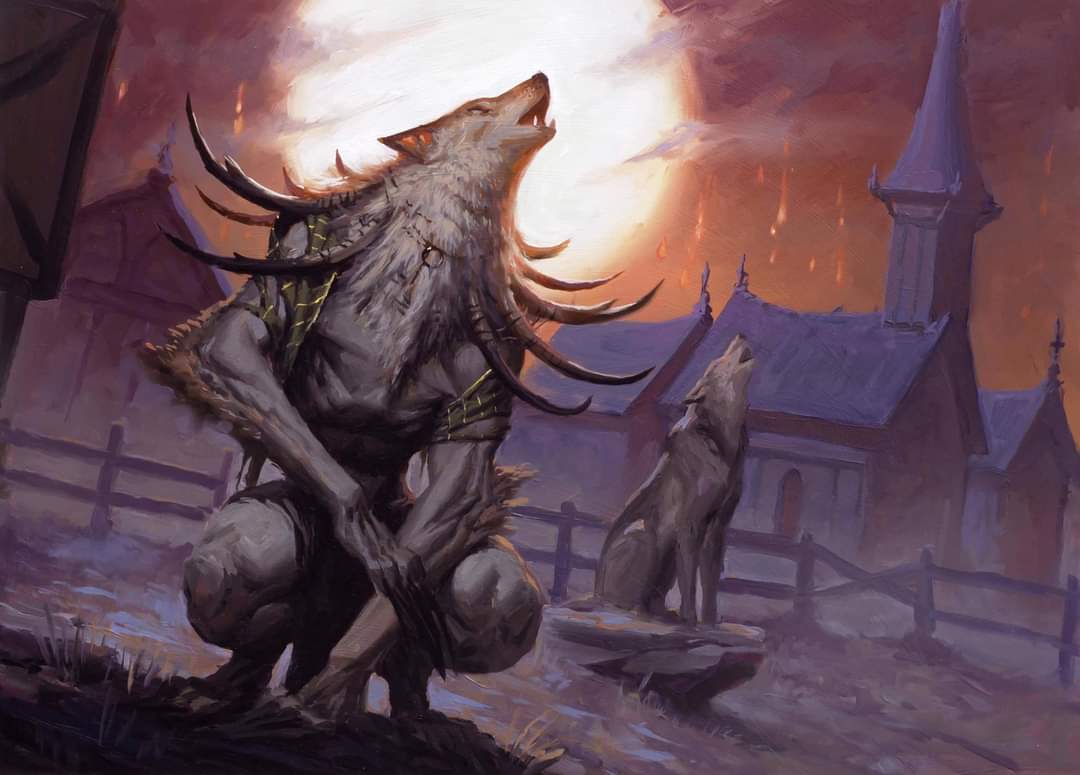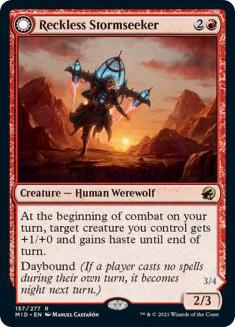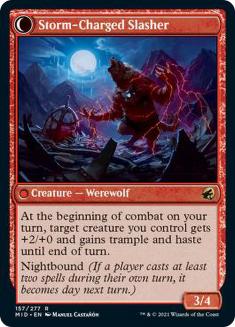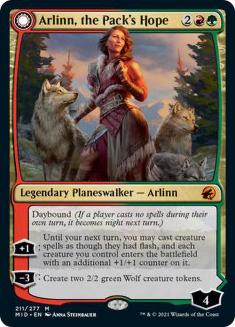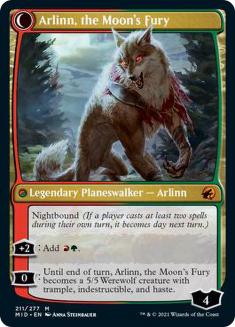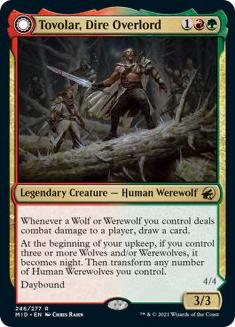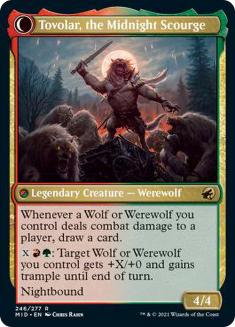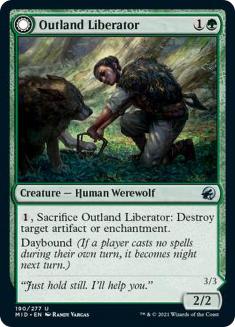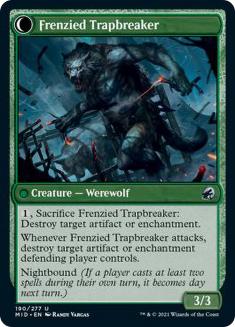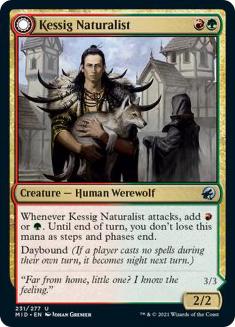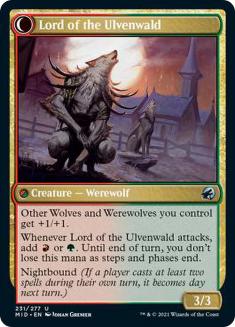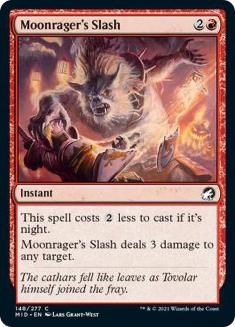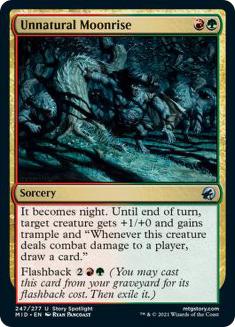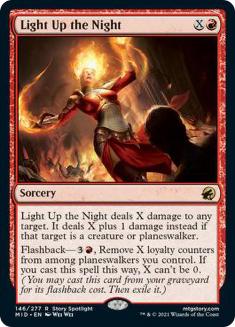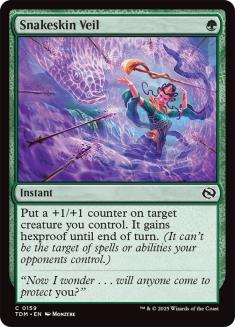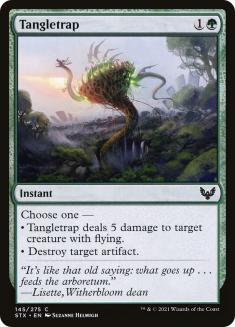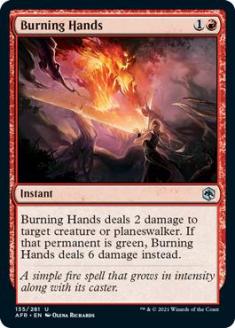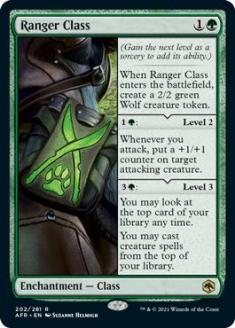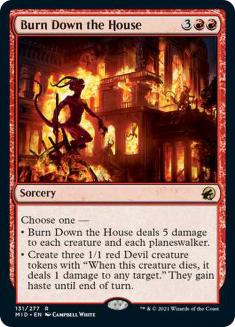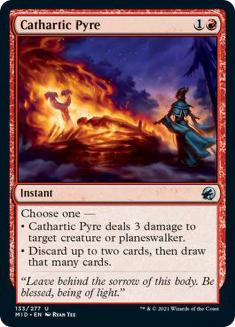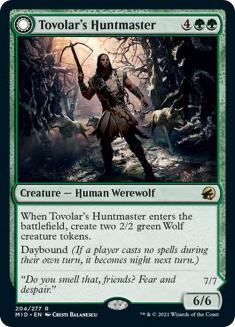When Wizards of the Coast (WotC) announced Innistrad: Midnight Hunt, we knew that Werewolves were going to be the focal point of the set. Regardless of that, it remained to be seen whether Werewolves were going to be actually good or mostly a gimmick; in previous Innistrad sets Werewolves as a theme were never any good (even though individual Werewolves, like Huntmaster of the Fells, were good), and even in themed sets the cards sometimes fall short for Constructed (such as Dinosaurs in Ixalan).
After playing with the set, I believe that Werewolf decks do have the legs to succeed in this Standard format. Here’s why:
- The deck punishes stumbles and awkward draws like no other. Most aggro decks will make short work of an opponent who doesn’t play a second or third land, but Gruul Werewolves demands more from an opponent than any other deck because, if they miss a beat, then all your creatures get multiple Glorious Anthems’ worth of bonuses. This is not only about hitting all their land drops but also about finding spells to cast turn after turn. Sometimes you cast a Turn 2 Werewolf and your opponent foretells and the game is basically over, even though they theoretically had a play! This ability to punish hands that aren’t above-average is worth a lot.
- The deck attacks from many different angles. It’s a creature deck, but you need to deal with Esika’s Chariot; Arlinn, the Pack’s Hope; Ranger Class; creature-lands; and potentially Wrenn and Seven. This, on top of having haste creatures, makes the deck very resilient to both sweepers and one-for-one removal spells.
- The deck has a lot of card drawing, which is not so common for aggro decks. Tovolar, Dire Overlord draws a bunch of cards; Werewolf Pack Leader draws cards; Unnatural Moonrise draws cards; and Ranger Class effectively draws cards. This, on top of having creature-lands and modal DFCs, means you almost never flood out.
That is the good part about the deck. This is the bad part:
- The deck can be kinda clunky. You have no one-drops, so you’re mostly casting one spell per turn until later in the game, which means you sometimes die with a ton of cards in your hand — it’s no help to draw a ton of extra cards if you can still just cast one of them. This also makes it so that the deck is much worse on the draw than on the play.
- The deck doesn’t have a lot of reach (specifically, it doesn’t have flyers). There are still some options to break through (you have a lot of trampling damage with Tovolar, the Midnight Scourge and Ranger Class will eventually overpower anything), but sometimes the ground gets gummed up and you just die to a Goldspan Dragon.
Before I talk about the individual additions from Innistrad: Midnight Hunt, we should first discuss the new Werewolf mechanic, because it’s caused quite a bit of confusion, especially among players who were already playing when the original Werewolves came out. The day/night mechanic in the set has three quirks:
- Werewolves will enter the battlefield already transformed if it’s night.
- Once you cast a daybound card (or a card that makes it day, like Sunstreak Phoenix), then day/night is tracked forever, even if these cards are no longer on the battlefield. In a scenario where you cast a Turn 2 Werewolf and they kill it at the end of the turn, if they untap and pass, then it will become night even if the Werewolf is not on the battlefield.
- You can only trigger day/night changes on your own turn. If I pass the turn without casting a spell, it doesn’t matter if you cast a spell; it’s still going to become night. Similarly, if you cast two spells on my turn, that won’t force it to become day, only if you cast two spells on your own turn.
These changes mean that overall it’s easier to get to the “back side” of Werewolves than it was before. You should expect it to be a normal occurrence that it’s nighttime, or at least much more common than it was before. Control decks, for example, used to be able to just pass and cast two spells on your turn to transform your Werewolves, but you can no longer do that.
Now, on to the cards:
In our Innistrad: Midnight Hunt First Impressions: Standard article, I had Reckless Stormseeker as the second-best card in the set. After playing with the card more, I’m left wondering if I was too restrained on it. This card is just really, really strong, and it’s enabled some very powerful starts. It combos extremely well with Esika’s Chariot as a Turn 3 into Turn 4 curve, and if it’s nighttime it can attack for five trampling damage by itself. This will be a staple in non-Werewolf red decks, so we’re obviously playing four copies in our Werewolves-themed deck.
Arlinn is a little bit of a Gideon, Ally of Zendikar, except not as strong because you don’t fully control her. Sometimes you really want to make tokens and can’t, and sometimes you really want to attack and can’t. If you’re doing the thing you want, however, then she’s excellent. Her [+0] turns her into a trampling Hazoret the Fervent! On top of that, her [+1] allows you to pass the turn, transform your Werewolves, and then cast all your creatures. I don’t think she’s a must play four-of, but she has been quite good, especially because the tokens being Wolves is very relevant.
This is another super-strong card. It’s not hard to cast a Wolf or Werewolf Turn 2 and then just follow it with Tovolar, Dire Overlord and immediately draw a card. Both extra abilities on this card are quite relevant as well — you use the first ability to transform your Werewolves quite often, and the Kessig Wolf Run effect on the back side is your best way of breaking through a battlefield stall. This card has a lot of abilities, so it’s easy to forget something that it does.
The biggest upside of Outland Liberator is that it’s a two-drop that gets day/night going. If you don’t cast a daybound card, the opponent will not be forced to cast something on Turn 2, but this starts that pressure very early. I’m not sure I want the full four copies but it’s definitely possible.
I started with one copy but this has grown on me a lot. There’s a reasonable number of artifacts and enchantments in this format (Esika’s Chariot and Showdown of the Skalds being the most common) and its ability to incidentally destroy them by attacking comes up a lot. Since you often don’t need to pay anything for it, you end up sniping things such as Treasure tokens as well.
The front side of Kessig Naturalist is not that good (it’s a worse Magda, Brazen Outlaw), but it’s a two-drop Werewolf that also gets day/night going, and the back side is quite strong, as a 3/3 lord for two mana is nothing to scoff at. Sometimes they don’t have a blocker and you get a Chariot or Arlinn on the battlefield on Turn 3 and that’s pretty good.
It’s relatively easy to control day/night, so Moonrager’s Slash ends up acting as a Lightning Bolt a lot. The problem is that it’s not a Lightning Bolt when you’d most need it to cost one (Turn 1), and there are no other instants in the deck, so if you pass the turn to turn day into night, then it doesn’t really matter that it cost one mana instead of three; you’re not going to do anything else with your spare mana. There are some exceptions to this, though; you could have used your mana to level up Ranger Class, you could have Arlinn to cast creatures with flash, or you could simply have two Moonrager’s Slashes. All in all, the “fail case” of three damage for three mana is not that bad, so currently I have this in my deck, but I definitely don’t think this is Lightning Bolt even if it looks like it.
I was skeptical about Unnatural Moonrise, but it’s actually been pretty good. For two mana it often replaces itself and gets in for a lot of damage (sometimes four or more). Then, if your opponent manages to produce two spells very early in the game, you can always flash it back.
One sequence that’s not that uncommon is going Turn 2 Outland Liberator and having your opponent follow it with Turn 2 Ranger Class. Then you cast Unnatural Moonrise and attack, which results in spending two mana to draw a card, deal two extra damage (four total because you might not have wanted to attack), destroy Ranger Class and turn the game into night for the foreseeable future — and then the card is still in the graveyard for you to use again later on!
Wrenn and Seven is undeniably strong, and it’s been making a ton of waves with Esika’s Chariot in green decks everywhere. In spite of that, I didn’t think it was that good in this deck. Five is a lot of mana, and that’s about the time you want to be killing your opponent, not casting a large creature without haste. I think this might have a place in certain matchups (creature mirrors if you wanna go more control with removal), but I haven’t liked it in the maindeck.
Light Up the Night is pretty decent, but I cut it from the deck when I cut Wrenn and Seven, as I think you really want to be able to flash it back a reasonable number of times. It’s an interesting card to keep in mind, though.
This is the list I’ve been playing:
Creatures (18)
- 4 Werewolf Pack Leader
- 3 Tovolar, Dire Overlord
- 4 Kessig Naturalist
- 4 Reckless Stormseeker
- 3 Outland Liberator
Planeswalkers (4)
Lands (21)
Spells (17)

The sideboarding is highly experimental, but this is the rough idea:
Snakeskin Veil is for decks full of removal. A lot of the deck costs two mana, so it’s not uncommon to go Turn 2 cast a two-drop, and then Turn 3 cast another two-drop and keep mana up for Veil. It’s possible this should be three copies.
Tangletrap is the best answer to Dragons in these colors.
For other green decks, especially Mono-Green Aggro. If that deck is popular, you really want four Burning Hands. It’s not that great versus the Gruul decks though because it doesn’t kill Goldspan Dragon or Reckless Stormseeker.
For grindy matchups.
Burn Down the House is an experiment versus other aggro decks. The fact that it has a mode if the game is at parity or slightly favorable makes me interested. It’s hard to rely too much on it though because of Esika’s Chariot.
I think you want some sideboard removal that kills Reckless Stormseeker and Cathartic Pyre is the best one.
Tovolar’s Huntmaster is for other green decks as well. The goal of the sideboard plan is to have a bunch of removal spells and turn into a midrange deck. If it’s night it doesn’t even die to Burning Hands, which is pretty good.
The same as Tovolar’s Huntmaster except it’s better versus Dragons and worse versus ground creatures.
Overall, I’ve had a ton of fun playing this deck and I actually think it’s very competitive. If you thought Werewolves were a gimmick, I urge you to give it a try!

